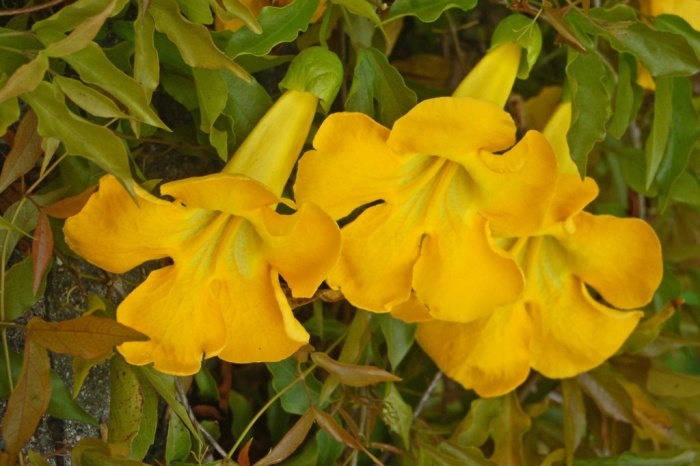Cat’s Claw Creeper
(Dolichandra unguis-cati)
Cat’s Claw Creeper (Dolichandra unguis-cati)
/
/

Hectonichus
CC BY-SA 3.0
Image By:
Hectonichus
Recorded By:
Copyright:
CC BY-SA 3.0
Copyright Notice:
Photo by: Hectonichus | License Type: CC BY-SA 3.0 | License URL: https://creativecommons.org/licenses/by-sa/3.0 | Uploader: Hectonichus | Publisher: Wikimedia Commons | Title: Dolichandra_unguis-cati03.jpg | Notes: {{Information |Description= {{de|[[:de:Gemeine Drachenwurz|Gemeine Drachenwurz]] (''[[Dracunculus vulgaris]]'')}} |Source=own work |Date=2007-05-30 |Author=[[User:LC-de|Jörg Hempel]] }} |



















































Estimated Native Range
Summary
Dolichandra unguis-cati, commonly known as Cat’s Claw Creeper, is a perennial vine that can be evergreen or semi-deciduous depending on the climate. It is native to tropical dry forests and rainforests of the Neotropics, including Central and South America, and the Caribbean. This vine is known for its rapid growth, reaching lengths of up to 50 feet (15 meters) or more, and it uses its namesake claw-like tendrils to climb over other vegetation and structures. The flowers are bright yellow, trumpet-shaped, and typically 4 to 5 cm (1.6 to 2.0 in) in diameter, blooming in clusters from late spring to early summer. The vine’s ability to spread both horizontally and vertically allows it to blanket the forest canopy and smother other plants.
Cat’s Claw Creeper is valued for its ornamental yellow flowers and its versatility in growing under a range of light conditions, from full sun to full shade. It is often used for covering walls, trellises, and fences in gardens. However, its aggressive growth habit requires careful management to prevent it from becoming invasive. In cultivation, it prefers fertile, well-drained soils but is adaptable to various soil types, excluding saline soils. It has low water requirements once established. Gardeners should be aware of its potential to spread rapidly and should consider containment strategies to prevent it from escaping cultivation.CC BY-SA 4.0
Cat’s Claw Creeper is valued for its ornamental yellow flowers and its versatility in growing under a range of light conditions, from full sun to full shade. It is often used for covering walls, trellises, and fences in gardens. However, its aggressive growth habit requires careful management to prevent it from becoming invasive. In cultivation, it prefers fertile, well-drained soils but is adaptable to various soil types, excluding saline soils. It has low water requirements once established. Gardeners should be aware of its potential to spread rapidly and should consider containment strategies to prevent it from escaping cultivation.CC BY-SA 4.0
Plant Description
- Plant Type: Vine
- Height: 30-40 feet
- Width: 15-24 feet
- Growth Rate: Rapid
- Flower Color: Yellow, Orange
- Flowering Season: Spring
- Leaf Retention: Deciduous, Evergreen
Growth Requirements
- Sun: Full Sun, Part Shade, Full Shade
- Water: Low
- Drainage: Slow, Medium, Fast
Common Uses
Drought Tolerant, Fragrant, Showy Flowers
Natural Habitat
Native to tropical dry forests and rainforests of the Neotropics
Other Names
Common Names: Catclaw Vine, Claw Vine, Catclawvine, Macfadyena, Funnel-Creeper, Cat’s-Claw, Catclaw-Creeper, Catclaw-Trumpet, Katteklouranker, Krallentrompete
Scientific Names: , Macfadyena unguis-cati, Dolichandra unguis-cati, Bignonia tweediana, Bignonia unguis, Bignonia unguis-cati, Doxantha unguis-cati, Bignonia exoleta, Doxantha unguis-cati var. exoleta, Doxantha exoleta
GBIF Accepted Name: Dolichandra unguis-cati (L.) L.G.Lohmann